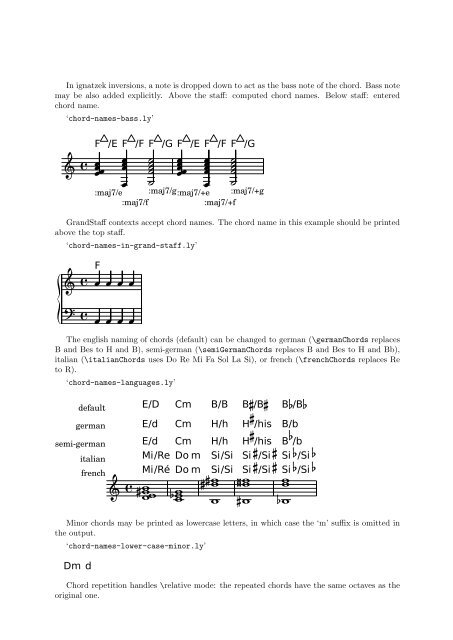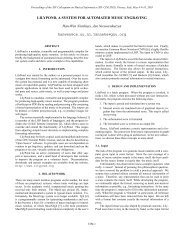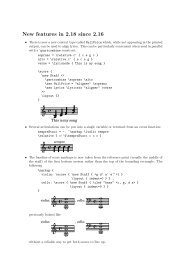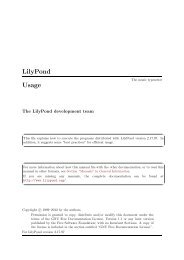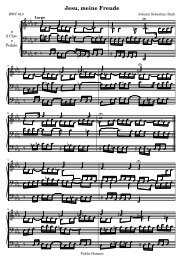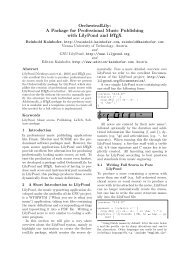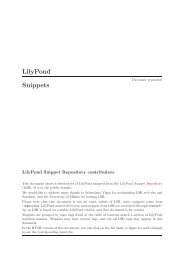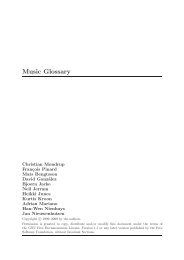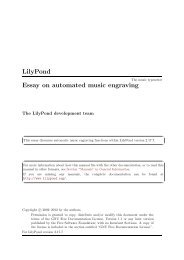- Page 1 and 2:
LilyPond Regression Tests
- Page 3 and 4: Regression test cases Accidentals a
- Page 5 and 6: ‘accidental-ledger.ly’
- Page 7 and 8: Tied notes with accidentals do not
- Page 9 and 10: The command \alterBroken may be use
- Page 11 and 12: ‘arpeggio-bracket.ly’ Arpeg
- Page 13 and 14: ‘auto-beam-exceptions.ly’ 4 2
- Page 15 and 16: ‘autobeam-nobeam.ly’
- Page 17 and 18: 2 12 16 1/8 beams
- Page 19 and 20: ‘baerenreiter-sarabande.ly’ Sar
- Page 21 and 22: 25 Segno bar lines can be used to
- Page 23 and 24: (1) 3 (4) (7)
- Page 25 and 26: ‘bar-number-volta-repeat.ly’
- Page 27 and 28: 30
- Page 29 and 30: … 2 3 4
- Page 31 and 32: 3 4 5 6
- Page 33 and 34: ‘beam-collision-beamcount.ly’
- Page 35 and 36: 3
- Page 37 and 38: Beams can be typeset over fixed dis
- Page 39 and 40: Beams can be typeset over fixed dis
- Page 41 and 42: In complex configurations of knee b
- Page 43 and 44: 6 (2.19,2.19) 12
- Page 45 and 46: ‘beam-single-stem.ly’ Beams
- Page 47 and 48: ‘bend-after.ly’
- Page 49 and 50: ‘bookpart-variable.ly’
- Page 51 and 52: The default callback for break-alig
- Page 53: Cm 7 D The 11 is only adde
- Page 57 and 58: ‘chord-tremolo-whole.ly’ Ch
- Page 59 and 60: 8 ‘clef-oct.ly’ 8 9 15
- Page 61 and 62: ‘clip-systems.ly’ bla
- Page 63 and 64: Single head notes may collide. ‘c
- Page 65 and 66: When merging heads, the dots are me
- Page 67 and 68: Note head completion may be broken
- Page 69 and 70: ‘context-mod-context.ly’
- Page 71 and 72: Clefs for cue notes should not infl
- Page 73 and 74: ‘define-event-function.ly’ p
- Page 75 and 76: • moving dots up. ‘dots.ly’
- Page 77 and 78: ‘dynamics-alignment-breaker-subse
- Page 79 and 80: ‘dynamics-hairpin-length.ly’
- Page 81 and 82: Empty chords accept articulations,
- Page 83 and 84: ‘figured-bass-continuation.ly’
- Page 85 and 86: ‘fill-line-test.ly’ 1 2 1 3 2 1
- Page 87 and 88: ‘fingering-cross-staff.ly’
- Page 89 and 90: TM and No should not be changed int
- Page 91 and 92: 2 k l * † ‡ § 3
- Page 93 and 94: 7 2 13 15 17 14
- Page 95 and 96: 2 k l 5 7 6 8 3
- Page 97 and 98: 2 2 foo 4 3 … bar
- Page 99 and 100: ‘footnote-footer-padding.ly’
- Page 101 and 102: 7 2 11
- Page 103 and 104: ‘footnote.ly’ a b 1 d 2 f 3 h i
- Page 105 and 106:
‘fret-diagram-origins.ly’ C X O
- Page 107 and 108:
The size, spacing, and symbols used
- Page 109 and 110:
8 ff 9 Broken glissandi anticip
- Page 111 and 112:
Glissandi are not broken. Here a \b
- Page 113 and 114:
‘grace-nest2.ly’ In ne
- Page 115 and 116:
‘grace-types.ly’ W
- Page 117 and 118:
With grid lines, vertical lines can
- Page 119 and 120:
5 Hairpin grobs do not collide
- Page 121 and 122:
‘hara-kiri-alive-with.ly’
- Page 123 and 124:
3 4 Staves, RhythmicSta
- Page 125 and 126:
4 2 stanza numbers remain, eve
- Page 127 and 128:
‘header-book-multiple.ly’ Title
- Page 129 and 130:
‘header-bookpart-multiple.ly’ T
- Page 131 and 132:
Piece correct (set at top level)
- Page 133 and 134:
‘identifiers.ly’
- Page 135 and 136:
23 27 31 35 39 43 2 1
- Page 137 and 138:
2 The Voice.instrumentCu
- Page 139 and 140:
‘instrument-name-markup.ly’ Cla
- Page 141 and 142:
The switchInstrument music function
- Page 143 and 144:
Key signatures may appear on key ch
- Page 145 and 146:
6 7 8 9 10 2
- Page 147 and 148:
‘ledger-line-shorten.ly’ 4 2
- Page 149 and 150:
The ligature bracket right-end is n
- Page 151 and 152:
Polyphonic rhythms and rests do not
- Page 153 and 154:
2 e d c A LyricExtender may sp
- Page 155 and 156:
Melismata may be entered manually b
- Page 157 and 158:
Adding a Bar_engraver to the Lyrics
- Page 159 and 160:
The implicit directional marks, U+2
- Page 161 and 162:
‘markup-eps.ly’ The eyeglass
- Page 163 and 164:
‘markup-music-glyph.ly’ c'est
- Page 165 and 166:
The \path markup command supports t
- Page 167 and 168:
‘markup-syntax.ly’ foo bar
- Page 169 and 170:
‘mensural.ly’ 9
- Page 171 and 172:
A metronome marking can be added to
- Page 173 and 174:
MIDI and partial measures work toge
- Page 175 and 176:
‘midi-unisons.ly’ … …
- Page 177 and 178:
‘morgenlied.ly’ Sängers Morgen
- Page 179 and 180:
‘mozart-hrn-3.ly’ Allegro p
- Page 181 and 182:
Horn in F 39 …
- Page 183 and 184:
The multimeasure rest is centered e
- Page 185 and 186:
2 3 2 7 Round up to the longer rest
- Page 187 and 188:
‘newaddlyrics.ly’ My N
- Page 189 and 190:
Notes can be set in the Sacred Harp
- Page 191 and 192:
57 kievan … 12 22 Notes ca
- Page 193 and 194:
‘one-line-breaking.ly’ 2. 8
- Page 195 and 196:
6 2 9 Music e
- Page 197 and 198:
‘override-nest-scheme.ly’ S
- Page 199 and 200:
2 If a page break is forced where
- Page 201 and 202:
2 01 Music engraving by LilyPond
- Page 203 and 204:
2 02 Music engraving by LilyPond 2.
- Page 205 and 206:
4 3 Music engraving by LilyPond 2
- Page 207 and 208:
‘page-breaking-min-distance3.ly
- Page 209 and 210:
12 2 14 15 16 17 Music e
- Page 211 and 212:
‘page-breaking-outside-staff-esti
- Page 213 and 214:
2 2 Music engraving by LilyPond 2
- Page 215 and 216:
‘page-breaking-page-count3.ly’
- Page 217 and 218:
2 A B C D E F G H I J K L M N O P Q
- Page 219 and 220:
5 2 7 Music engra
- Page 221 and 222:
4 2 5 6 Music engraving by Li
- Page 223 and 224:
5 2 Instrument 6 7 8
- Page 225 and 226:
‘page-headers-and-footers.ly’ f
- Page 227 and 228:
3 last-page-header-text 13 14
- Page 229 and 230:
First score 3 A (page 3) 2
- Page 231 and 232:
‘page-layout-manual-position.ly
- Page 233 and 234:
The space between systems can be li
- Page 235 and 236:
page top 3 6 7 8 9
- Page 237 and 238:
Links to labels and explicit page n
- Page 239 and 240:
2 B Music engraving by LilyPond
- Page 241 and 242:
2 Text Text Tagline The minimal pag
- Page 243 and 244:
2
- Page 245 and 246:
‘page-spacing-dynamics.ly’ f
- Page 247 and 248:
‘page-spacing-nonstaff-lines-betw
- Page 249 and 250:
‘page-spacing-nonstaff-lines-head
- Page 251 and 252:
A non-staff line (such as Lyrics) a
- Page 253 and 254:
2 3 StaffGroups can be nest
- Page 255 and 256:
‘page-spacing-stretchability.ly
- Page 257 and 258:
‘page-spacing-system-count-overfu
- Page 259 and 260:
‘page-spacing-tall-headfoot.ly’
- Page 261 and 262:
10 t a l l h e a d e r t a l l f
- Page 263 and 264:
2 2 Music engraving by LilyPond 2
- Page 265 and 266:
By setting page-top-space, the Y po
- Page 267 and 268:
‘page-turn-page-breaking-auto-fir
- Page 269 and 270:
‘page-turn-page-breaking-auto-fir
- Page 271 and 272:
‘page-turn-page-breaking-repeats.
- Page 273 and 274:
8 26
- Page 275 and 276:
‘paper-default-margins-def.ly’
- Page 277 and 278:
‘paper-margins-consistency.ly’
- Page 279 and 280:
‘paper-margins-left-margin.ly’
- Page 281 and 282:
‘paper-margins-line-width.ly’
- Page 283 and 284:
‘paper-margins-no-checks.ly’
- Page 285 and 286:
‘paper-margins-overrun.ly’
- Page 287 and 288:
‘paper-margins-right-margin.ly’
- Page 289 and 290:
‘paper-margins.ly’
- Page 291 and 292:
‘paper-nested-override2.ly’ 2.8
- Page 293 and 294:
85 ‘paper-twosided-bcorr.ly’
- Page 295 and 296:
195
- Page 297 and 298:
85 ‘paper-twosided.ly’
- Page 299 and 300:
195
- Page 301 and 302:
‘part-combine-a2.ly’ 2 a2
- Page 303 and 304:
The part combiner detects a2, solo1
- Page 305 and 306:
The standard piano pedals style com
- Page 307 and 308:
‘profile-property-access.ly’ Li
- Page 309 and 310:
‘quote-cue-during.ly’ quoteMe o
- Page 311 and 312:
‘quote-kill-cues.ly’
- Page 313 and 314:
When a score takes up only a single
- Page 315 and 316:
3 Rests should not keep sta
- Page 317 and 318:
… … … The two dots of a repea
- Page 319 and 320:
… excentric four-line staff ve
- Page 321 and 322:
Tremolos work with chord repetition
- Page 323 and 324:
‘rest-collision-beam-restdir.ly
- Page 325 and 326:
9
- Page 327 and 328:
81 93
- Page 329 and 330:
‘rest.ly’ … … … …
- Page 331 and 332:
\consists can take a scheme alist a
- Page 333 and 334:
9 17 Scripts use skylines with accu
- Page 335 and 336:
In addition to Slur, the music func
- Page 337 and 338:
‘size26.ly’ 1. 2. 4 cuivr
- Page 339 and 340:
‘skyline-horizontal-padding.ly’
- Page 341 and 342:
‘slur-avoid.ly’ Across lin
- Page 343 and 344:
‘slur-dash.ly’
- Page 345 and 346:
An additional opening slur during a
- Page 347 and 348:
‘slur-script.ly’
- Page 349 and 350:
‘song-breathe.ly’ 4 3 play t
- Page 351 and 352:
Accidentals in different staves do
- Page 353 and 354:
Empty barlines do not affect spacin
- Page 355 and 356:
‘spacing-horizontal-skyline-grace
- Page 357 and 358:
In the absence of NoteSpacings, wid
- Page 359 and 360:
‘spacing-short-notes.ly’ 4
- Page 361 and 362:
The SpanBarStub grob takes care of
- Page 363 and 364:
Span bars are drawn only between st
- Page 365 and 366:
‘staff-change-autobeam.ly’
- Page 367 and 368:
‘stem-cross-staff-articulation.ly
- Page 369 and 370:
‘stem-shorten.ly’
- Page 371 and 372:
‘stencil-scale.ly’ String num
- Page 373 and 374:
System separator positioning works
- Page 375 and 376:
System separators may be defined as
- Page 377 and 378:
When the staff-space is increased,
- Page 379 and 380:
Context property defaultStrings def
- Page 381 and 382:
When a harmonic note is tied in tab
- Page 383 and 384:
8 3 2 0 0 0 0 0 1 5
- Page 385 and 386:
‘test-output-distance.ly’
- Page 387 and 388:
2 Ties behave properly at line
- Page 389 and 390:
In the single tie case, broken ties
- Page 391 and 392:
… …… … …… 4 …
- Page 393 and 394:
4 Second score Music engraving b
- Page 395 and 396:
The trill symbol and the wavy line
- Page 397 and 398:
With full-length-to-extent, the ext
- Page 399 and 400:
Tuplet number position is correct w
- Page 401 and 402:
‘typography-demo.ly’ LilyPond d
- Page 403 and 404:
Broken volta spanners behave correc
- Page 405 and 406:
‘warn-unterminated-span-dynamic.l
- Page 407:
Lists all possible keys for all ins


